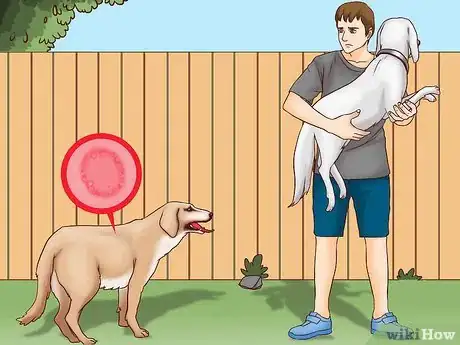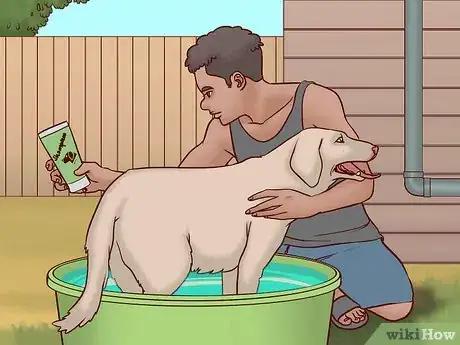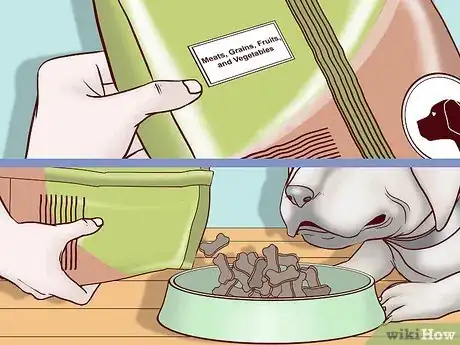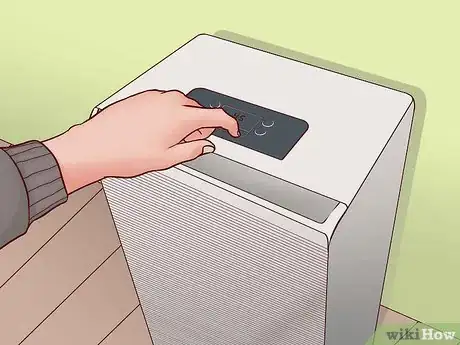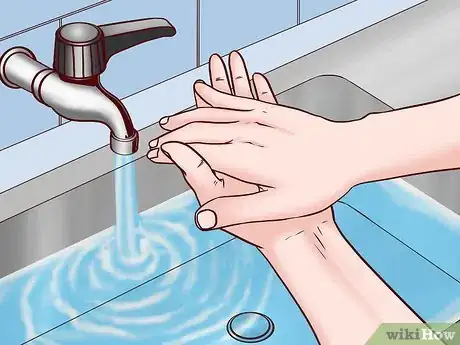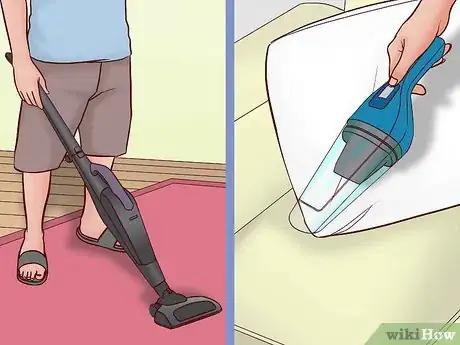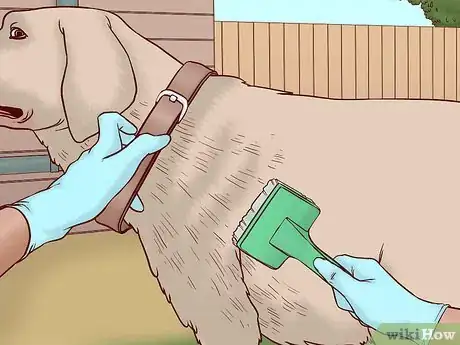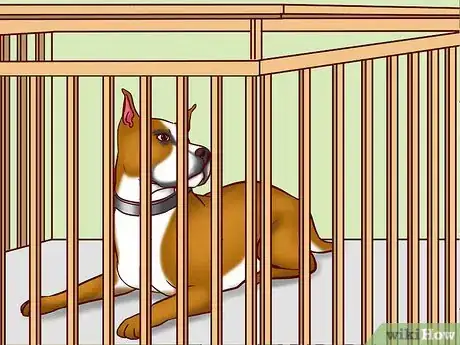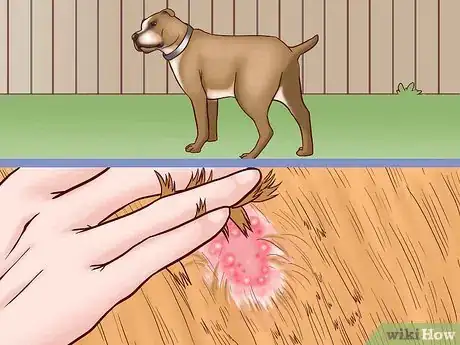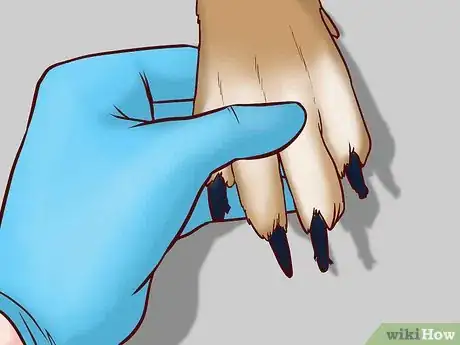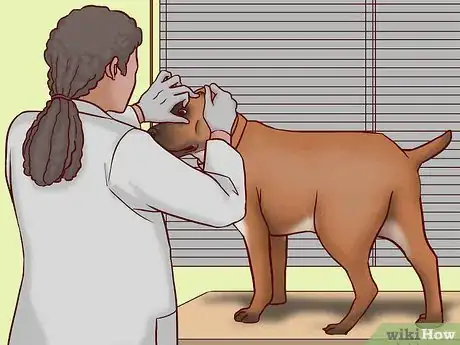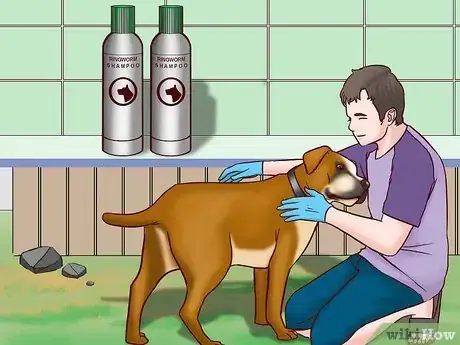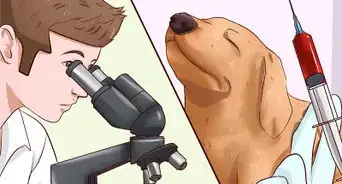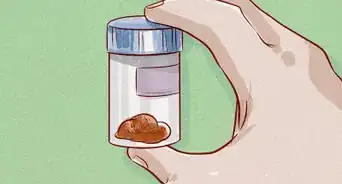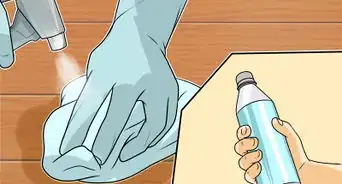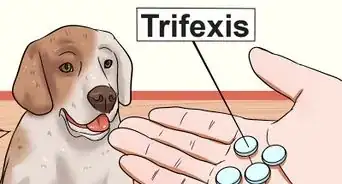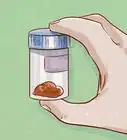This article was co-authored by Pippa Elliott, MRCVS. Dr. Elliott, BVMS, MRCVS is a veterinarian with over 30 years of experience in veterinary surgery and companion animal practice. She graduated from the University of Glasgow in 1987 with a degree in veterinary medicine and surgery. She has worked at the same animal clinic in her hometown for over 20 years.
There are 7 references cited in this article, which can be found at the bottom of the page.
This article has been viewed 49,840 times.
If you’d like to keep your dog ringworm-free, there are several things you can to do try to prevent the condition in your dog. It is also important to know how to spot ringworm, as quickly identifying the condition will help prevent future infections. It’s easier to prevent ringworm than it is to get rid of it, so following preventative steps can save you quite a bit of headache. If your dog has already had 1 case of ringworm, you’ll need to keep its living environment clean to prevent a second case.
Steps
Keeping Your Dog Ringworm-Free
-
1Keep your dog away from animals already infected with ringworm. Ringworm is extremely infectious, and dogs can easily catch it from other dogs or cats with the skin condition. To keep your dog ringworm-free, don’t let it have any interaction with other people’s pets if they have ringworm. Dogs are especially susceptible to the fungus in vet’s waiting rooms, so avoid contact with other pets that are being treated for ringworm.[1]
- Dogs can even catch ringworm from humans! If one of your friends or family members mentions that they have ringworm, don’t let them pet your dog.
- Watch for signs of hair loss from your dog since it could be a symptom of ringworm infection. Contact a vet as soon as you notice your dog losing any hair.
- If you fear that your dog did come into contact with ringworm, use an antifungal shampoo immediately to prevent it from spreading.
-
2Wash your dog regularly with dog shampoo to keep it clean. Maintaining your dog’s general hygiene is a key step in preventing the animal from contracting ringworm. Bathe your dog about once a month using a pet shampoo recommended by your veterinarian. Note that you should not use a medicated shampoo unless one has been prescribed by a vet. When you wash the dog, lather up its entire coat with the shampoo, and rinse them thoroughly with the shower head.[2]
- Never use human shampoo on dogs. The 2 types of shampoo are not similar, and human shampoo will not effectively clean your dog’s fur.
- Dry the dog with a towel until it’s completely dry, or let it air dry by running outside on a warm day.
- If you don’t have time to wash the dog, invest in regular dog grooming sessions at a grooming center. Make sure that the groomer sterilizes their tools between different dogs, so they don’t accidentally pass ringworm from 1 animal to the next.
Advertisement -
3Feed your dog an antioxidant-rich diet to keep it in good health. A healthy dog is less likely to get ringworm, and a nutritious diet is a great way to keep your dog strong.[3] When you’re shopping for dog food, read the various labels to find the foods with the highest nutrient levels. Healthy food will include a good balance of meats, grains, fruits, and vegetables.[4] Feed your dog twice per day, once in the morning and once in the evening, to keep it well-fed but not let it become overweight.
- Avoid giving your dog table scraps—including things like cheese—more than 1 or 2 times per month. Although dogs love these snacks, the foods aren’t great for the dogs’ health.
- If you do want to give your dog occasional scraps, give it food like beans and potatoes. These are high in antioxidants and will keep the dog healthy.
- If you’re not sure about the best kind of food for your dog, ask your veterinarian to recommend a dry kibble or wet food—or both—that will suit your breed of dog and its lifestyle.
-
4Set up a dehumidifier in the room where your dog sleeps. Like all other fungi, the fungus that causes ringworm thrives in moist environments. If you live in a humid region or are having an especially wet rainy season, a dehumidifier can help cut back on moisture within your home. This, in turn, will decrease your dog’s chances of contracting ringworm. Set the machine up nightly in the room that your dog sleeps in to dry out the air.[5]
- Purchase a dehumidifier at a large hardware store or at a home-improvement store.
-
5Disinfect the dog’s kennel if you suspect it’s infected. In some cases (e.g., if you’re boarding the dog while you travel), your dog may use a kennel that another dog has recently stayed in. In this situation, disinfect the crate or kennel to prevent your dog from catching ringworm.[6] Try mixing together bleach and water at a 1:10 ratio in a plastic spray bottle. Spray the bleach mixture across the interior of the kennel, and wipe it clean with an old rag or a handful of paper towels.
- Be careful about the type of disinfectant you use, as some do not kill the fungal spores. Ones that do work include benzalkonium chloride, diluted bleach, and strong detergents.
Preventing a Recurring Infection
-
1Wash your hands after handling a ringworm-infected dog. Ringworm is zoonotic, which means that the condition can be transferred to human beings. In order to prevent yourself from contracting ringworm, wash your hands for 30 seconds with soap and water after handling a dog that is—or that may be—infected with ringworm.[7]
- If you know that you’re going to be touching a dog that has ringworm (e.g., to take it for a walk or to put on its medicated shampoo), put on a pair of gloves to keep your hands fungus-free.
- Young children, the elderly and the ill are more susceptible to transmission of ringworm from pets.
-
2Clean areas of your home that the dog sleeps and spends time in. Fungi spores can easily fall off of your dog and remain dormant in a rug, carpet, or sofa. If your home isn’t cleaned, the dog can get re-infected by brushing up against ringworm fungi. So, regularly clean all carpets, rugs, fabric-covered furniture, and drapery that your dog often comes into contact with.[8]
- Also wash the dog’s bedding on a weekly basis. Use hot water if possible, and line dry in direct sunshine or a hot setting of the dryer.
- Vacuum all areas likely to be affected by a ringworm infection daily, both during and after an infection, and as a precautionary measure. Dispose of the vacuumed contents in the outside trash can, in an enclosed bag.
- Keep your dog in one room of your home so it’s easier to clean and decontaminate.
- Also keep the dog’s food and water bowls clean. If possible, wash them with soapy water at the end of each day.
-
3Clean out the dog’s hair from its brush and dispose of the hair. Ringworm fungi tend to stick to dogs’ hairs, and when you brush the dog, the fungi cells stay on the brushed-out hairs on the brush. Pull all of the animal’s residual hair out of the brush daily. Throw the hair away in a trashcan with a lid, so the dog won’t accidentally come into contact with it.[9]
- If you’re concerned that your dog may already have a case of ringworm, wear a pair of gloves when you pull the hair out of the brush.
- A vet might suggest you cut a long-haired dog’s coat to reduce the amount of contaminated hair and help medicinal shampoo work better.
-
4Quarantine your dog for 6 weeks to prevent transmission. If your dog has been infected with ringworm, keep it quarantined from other dogs. Keep the dog home from doggy daycare, don’t take it to dog shows, and don’t let your dog spend time with the neighbors’ dogs. Quarantining your infected pup will prevent other dogs from catching the illness and prevent a neighborhood-wide outbreak.[10]
- This works the other way around; if your neighbor’s dogs have been infected, keep your dog well away for 6 weeks after treatment. If your neighbor’s pets have ringworm, talk to your neighbor about preventing contact with your pets.
- If your pup does have ringworm, try to keep the dog only in rooms that are easy to clean. This will minimize environmental contamination if an infection does start.
Spotting Signs of Ringworm
-
1Look for red, circular lesions on the dog’s skin. Ringworm infections occur most commonly on dogs’ heads, ears, tails, and front paws. However, any part of the animal’s body can be infected by ringworm. If you catch a ringworm infection early, it will appear pinkish in color. You’ll likely notice scaly skin pieces around the area and across the dog’s body. You might need to push apart the dog’s thick hair to see the skin underneath.[11]
- A well-established infection will show round, slightly raised, rash-like lesions, and the skin covering the lesion and look scaly and grey.
-
2Note bare patches of skin where the hair has fallen off. This is a reliable sign of ringworm in dogs. The spots may range in diameter from small 1 centimetre (0.39 in) circles to larger 4–5 inches (10–13 cm) hairless patches. You may also see patches on the skin that look as if someone has shaved the dog.[12]
- The bald skin itself may show the typical red circles associated with ringworm, or you may see bumpiness, pustules, shapeless inflammation, or crustiness.
- The technical term for this hair loss is alopecia.
-
3Check your dog’s claws to see if they are brittle and rough. While ringworm typically infects dogs’ skin, it can also spread to its feet. The main symptom of infected feet is seen in the claws, which become brittle and may snap off as the dog walks through your home. The claws also become very rough to the touch, as the outer layer of material peels off.[13]
- Hair around the infected foot also turns brittle and breaks off easily.
-
4Take your dog to the vet if you suspect it has a case of ringworm. A veterinarian will be able to inspect your dog’s skin, coat, and claws and diagnose it with ringworm. Do this as soon as possible once you suspect that your dog has ringworm. If you wait, the ringworm could worsen and become much harder to clear up.[14]
- The vet may request that you keep your animal in its crate or kennel to prevent it from passing ringworm to other animals in the office.
-
5Wash your dog with a medicated shampoo if it has ringworm. Despite your best efforts at prevention, your dog may end up with ringworm. In this case, the first thing to do is to visit your veterinarian. They’ll prescribe your dog a medicated antifungal shampoo. Wash the dog with the shampoo once daily (or as directed on the packaging) for 2–3 weeks. Make sure to wear plastic gloves while you’re washing the dog so you don’t catch the ringworm![15]
- If a medicated shampoo won’t work for your dog for some reason, the vet may prescribe an antifungal medicated cream or a pill to give the dog orally.
References
- ↑ https://www.vetwest.com.au/pet-library/ringworm-signs-diagnosis-and-treatment
- ↑ https://www.care.com/c/stories/6397/ringworm-in-dogs-what-to-do/
- ↑ https://www.care.com/c/stories/6397/ringworm-in-dogs-what-to-do/
- ↑ https://www.akc.org/expert-advice/nutrition/best-dog-food-choosing-whats-right-for-your-dog/
- ↑ https://www.manhattancats.com/article-archive/dermatology/ringworm/
- ↑ https://wagwalking.com/wellness/how-to-prevent-your-dog-from-getting-ringworm
- ↑ https://wagwalking.com/wellness/how-to-prevent-your-dog-from-getting-ringworm
- ↑ https://wagwalking.com/wellness/how-to-prevent-your-dog-from-getting-ringworm
- ↑ https://www.vetwest.com.au/pet-library/ringworm-signs-diagnosis-and-treatment
- ↑ https://www.vetwest.com.au/pet-library/ringworm-signs-diagnosis-and-treatment
- ↑ https://www.petmd.com/dog/conditions/skin/c_dg_dermatophytosis?page=show
- ↑ https://www.vetwest.com.au/pet-library/ringworm-signs-diagnosis-and-treatment
- ↑ https://www.akc.org/expert-advice/health/parasites/ringworm-in-dogs/
- ↑ https://www.vetwest.com.au/pet-library/ringworm-signs-diagnosis-and-treatment
- ↑ https://www.vetwest.com.au/pet-library/ringworm-signs-diagnosis-and-treatment
- ↑ https://www.vetwest.com.au/pet-library/ringworm-signs-diagnosis-and-treatment
About This Article
Ringworm is a contagious fungal infection that dogs can pick up easily from other animals or even humans. You can help keep your dog ringworm free by practicing good hygiene. Keep your dog away from other animals you know are infected, and bathe it frequently to wash off any possible contaminants. If you think your dog’s kennel might have been exposed to ringworm, clean the area with a 1 to 10 mixture of bleach and water to get rid of lingering spores. Ringworm thrives in humid environments, so keep a dehumidifier in the room where your dog sleeps to minimize moisture. Feeding your dog a healthy diet can also help boost its immune system and stave off infections, so ask your vet to recommend a good quality dog food. For more tips from our Veterinary co-author, including how to prevent a ringworm infection from coming back, read on!
